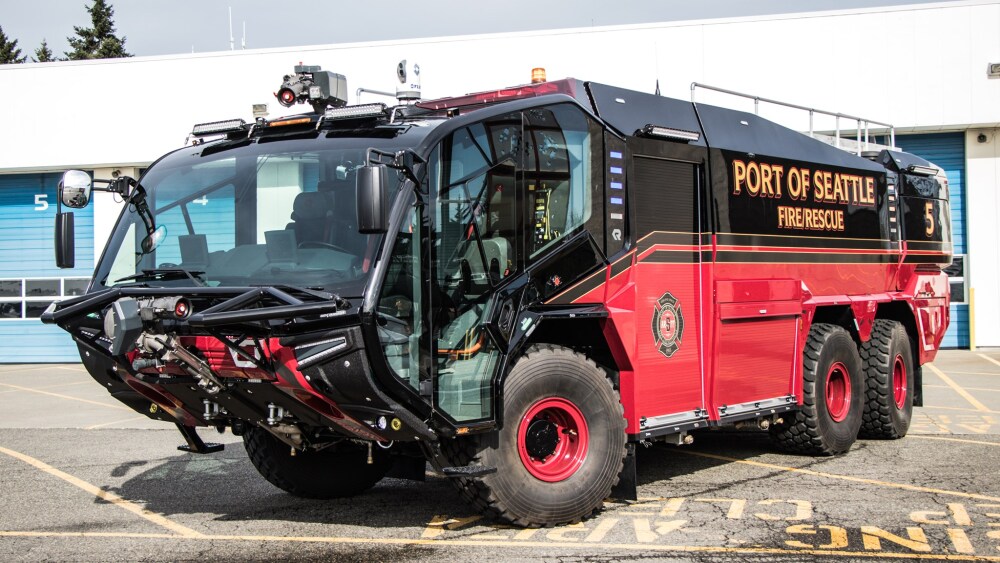By Isabella Breda
The Seattle Times
SEATTLE — Taxiing jet engines groaned on the tarmac, their fumes filling the Port of Seattle’s firetruck bays on an early summer day here. Snaking hoses connected tanks and filters in a complex cleanup operation.
Over six days, the system flushed a toxic substance from a firetruck as the department became one of the first in the nation to begin to remove firefighting foam concentrates laced with “forever chemicals.”
For decades, per- and polyfluoroalkyl chemicals, or PFAS, have been used in foams to put out the highest-intensity petroleum-fueled fires — especially important in saving lives amid catastrophes at airports, military bases and fossil fuel refineries.
But the chemicals have left a deadly legacy.
PFAS manufacturers knew the product was toxic yet concealed it for decades. The firefighters who were often covered in the foams during training exercises or fire responses, however, only learned of their harm to people and the environment in recent years.
As a wave of state and federal legislation and rule-making phase out the chemicals and offer safer alternatives, Sea-Tac says it’s the first U.S. airport to use a cleaning technology.
Washington will require the state’s 11 commercial airports to remove their PFAS products and replace them by fall 2025. The problem? They can’t just literally dump toxic chemicals. And some argue something more than water is needed to clean equipment.
How firefighters can protect themselves from PFAS:
Learn how you can limit your exposure to per- and polyfluoroalkyl, also known as PFAS, or “forever chemicals”
Washington airports must use PFAS-free firefighting foams
These 11 airports in Washington must transition away from firefighting foams that contain “forever chemicals,” or PFAS, by Sept. 30, 2025.
For some local firefighters who have lived through the PFAS era, and lost friends and colleagues along the way, the new requirements are a victory.
“It’s a little too late for some of my friends,” said former Port of Seattle fire union President Thomas Sanchez. “I’m super happy for the people who are there. Maybe they’ll have a little more longevity.”
“Should have been a warning”
After pouring 5-gallon buckets of yellow PFAS concentrate into their firetrucks’ tanks, firefighters’ hands would feel like they were covered in a “Teflon"-like film, Sanchez recalled. The substance on their skin would repel water and wouldn’t easily wash away, he said.
They trained with it until they were soaked in the white frothy liquid. Covering rookie firefighters in the foams was a rite of passage for some time.
“Everybody used it,” Sanchez said of the foam. “If you were in the fire service, you had foam on your truck.”
Firefighters were assured these foams were safe, biodegradable and did not pose a risk to the environment.
Then, people started getting sick.
Harry Evans was a Sea-Tac firefighter for 28 years. He was diagnosed with kidney cancer in 1993. He retired from the Port of Seattle Fire Department three years later. By 2006, the cancer spread to his pancreas and intestine.
Evans served alongside Gilbert Smith Jr . and was routinely exposed to PFAS foams during training, including quarterly pit fires. Just seven months after his retirement from the Port of Seattle , Smith, a 31-year retired veteran of the Sea-Tac crew, was diagnosed with pancreatic cancer. He died of the disease in 2015. He was 60.
In 2016, less than a year after Smith’s death, a third Sea-Tac firefighter, Alvin Vaughn , had been diagnosed with pancreatic cancer. He died last Christmas at 61.
Smith and Vaughn are now considered to have died in the line of duty.
Port of Seattle Fire Chief Randy Krause and his firefighters have had their blood tested, and many of the results, including his own, show elevated levels of different kinds of PFAS.
“Firefighters are handling buckets of the stuff, and they’re being exposed to it,” Michael White of the Washington State Council of Firefighters, testified to the Legislature in support of a 2018 bill to restrict the substances. He said he had “become an expert at watching my brothers and sisters get cancer.”
Meanwhile, 3M DuPont, Chemours and other manufacturers knew and concealed the toxicity of the chemicals for decades.
The strongly bonded fluorocarbons were “completely resistant to biodegradation,” according to a Jan. 9, 1978, internal 3M memo written by chemist Eric Reiner.
Other 3M studies documented the firefighting foam’s toxicity to fish, plant life and at high levels to laboratory animals that included Rhesus monkeys.
3M later confirmed the findings of independent researchers who in the 1970s found PFAS to be widespread in blood-bank samples, according to documents made public in federal court, and recently reported by ProPublica and The New Yorker.
By 1998, a company researcher had recommended a “safe” level of PFOS in the blood that was lower than that found in 3M population studies, court documents show.
“There should have been a warning to us,” Sanchez said. “But nobody ever said it was bad for you.”
“Put a little soap in there”
Inside the truck bays at Sea-Tac last week, contractors used a power drill to whip up a bucket of a solution with a honey-like consistency known as PerfluorAd.
The solution is comparable to an organic dishwashing soap — containing plant-based-oleic acid, like found in vegetable oil — said David Fleming, the founder of TRS, a Washington-based company contracted to clean the trucks.
Sea-Tac first U.S. airport to use a new PFAS foam removal method
TRS Group is using PerfluorAd technology to remove PFAS from aircraft rescue firefighting vehicles. Recovered PFAS are disposed of off-site; rinse water is treated on-site to remove the remaining traces of PFAS before being recycled or sent to the sanitary sewer.
Five commercial international airports in the U.S. have phased out their PFAS foams, Krause said. But Sea-Tac is the first to use a cleaning technology. Some others have just used water, he said.
“If you put the dishes in the dishwasher and you use cold water, do they come out clean? They don’t,” Krause said. “If you put in warm water, they may get a little bit cleaner, but you need the solution. So I put a little soap in there and it cleans it. We are doing that.”
The solution used in the process at Sea-Tac has been used in airports in Europe.
The Federal Aviation Administration, as well as the Defense Department, still required airports to have PFAS products on hand until the fall of last year, even as airports in Europe, Canada and Australia have moved to alternative foams.
It costs about $50,000 to $70,000 to clean each truck with this method, compared with over $1 million to purchase a new truck. Sea-Tac is cleaning out and transitioning five trucks to the new foams. Officials have also invited King County Airport to bring their trucks in for cleaning.
The solution is mixed with water and heated before being circulated into the tank and pipes on the truck, and then through a series of filters.
The PerfluorAd basically binds with the PFAS to pull it from the tank and pipes through a process called flocculation. It comes out as a jellylike substance and is diverted through filters which leave behind a PFAS sludge. The remaining water and solution are filtered through liquid granular activated carbon.
Treated water is stored in a large tank to be recycled through the process, or discharged into the sewer.
The King County Wastewater Division approved the sewer discharges. A representative from the Ecology Department also visited the site to observe the cleaning process.
Krause has been waiting for this moment for more than a decade.
He took the job as Port of Seattle fire chief in 2010 and has long been eager to rid the department of every last drop. He testified before the Legislature in favor of a bill that, after passage, restricted most in-state sales of the foams and required fire departments to stop training with the concentrate.
The bill was opposed by the Firefighting Foam Coalition and another industry group, the FluoroCouncil, formed by the American Chemistry Council.
Krause purchased a PFAS-free alternative that Sea-Tac crews tested in 2019. After the September 2023 approval of other materials by federal agencies, Sea-Tac moved forward with training with the other products and then purchased one of the approved products.
Joey Pierotti, president of the Port of Seattle fire union, is satisfied with the new product. He says it requires a bit more effort to put out a fire, but he considers it a worthy trade-off.
“Our original tactic was you hit [the fire] with this [PFAS-laced] foam and it pretty much killed it. Now it’s a little bit lengthier of a process, but still does the same job,” he said. “I think it’s a pretty good trade for long-term career health versus a little bit more work.”
(c)2024 The Seattle Times
Visit The Seattle Times at www.seattletimes.com
Distributed by Tribune Content Agency, LLC.







